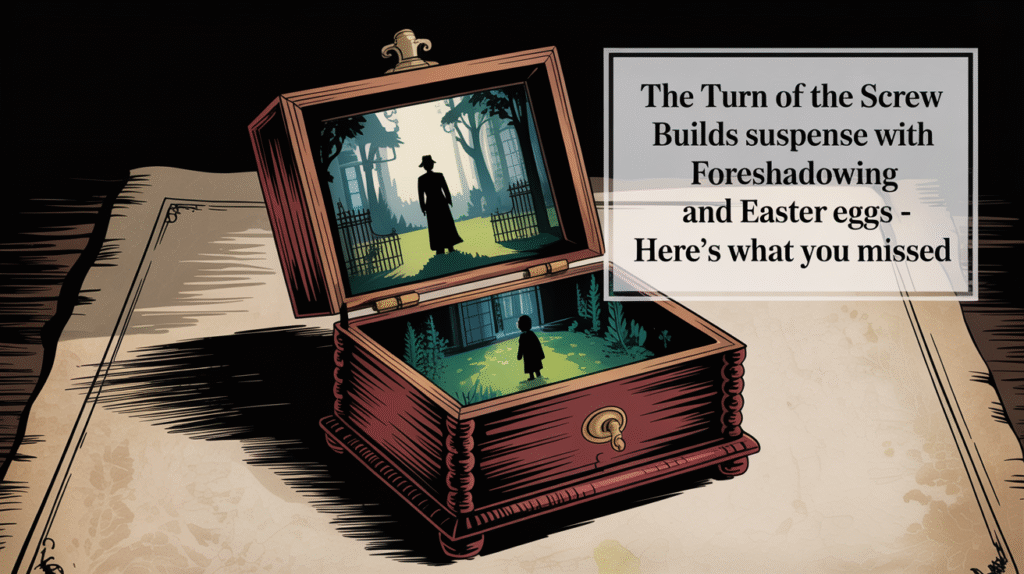The real brilliance of “The Turn of the Screw” lies in its use of foreshadowing and hidden details that quietly build dread, many of which readers overlook on their first read.

Henry James’s The Turn of the Screw is layered with subtle hints, symbolic moments, and narrative sleights of hand that set up future revelations or deepen the story’s ambiguity. These literary “easter eggs” are deliberately placed to reward attentive readers and challenge passive ones. In this guide, we’ll unpack the most effective uses of foreshadowing, revisit overlooked details, and explain how these elements transform the novella from a ghost story into a psychological maze.
Early Dialogue That Foreshadows Madness
Even before the governess begins narrating her story, the framing text lays the groundwork for psychological instability.
Douglas’s Introduction Hints at More Than Ghosts
In the prologue, Douglas praises the governess but also hints at tragedy.
- He emphasizes the story’s darkness and her courage in facing it.
- His reverence feels ominous, suggesting that her “heroism” may come at a cost.
The Phrase “Turn of the Screw”
The title itself is first used by Douglas, symbolizing increased psychological pressure.
- It implies that the story will grow darker with every revelation.
- It also cues the reader to expect escalating emotional tension rather than simple scares.
Subtle Changes in Flora and Miles’s Behavior
The children’s actions often foreshadow deeper disturbances beneath their innocent facades.
Miles’s Expulsion Is a Signpost
The unexplained expulsion raises suspicion long before any ghost appears.
- It suggests a hidden moral or behavioral problem.
- The vagueness foreshadows the novella’s theme of unseen corruption.
Flora’s Sudden Illness
Flora becomes sick after the governess confronts her about Miss Jessel.
- Her illness foreshadows the psychological toll the governess’s suspicions will take.
- It hints that the real threat may be emotional or mental, not supernatural.
Descriptions of the Estate as a Character
Bly itself drops constant hints that all is not as it seems, acting as a silent foreshadowing tool.
The Empty Rooms and Unused Spaces
Rooms in Bly are frequently mentioned as closed off or untouched.
- This detail reinforces the idea of hidden truths and emotional repression.
- It suggests secrets buried both in the estate and in the characters’ minds.
The Tower and the Lake Appear Before Ghosts
These locations gain meaning through repetition.
- The tower is linked to Quint even before he appears visually.
- The lake becomes eerie once Miss Jessel is seen nearby, adding symbolic weight.
Ghost Sightings Aligned with Emotional Triggers
Each supernatural appearance coincides with a moment of emotional strain for the governess.
The First Sightings
Quint appears just as the governess feels overwhelmed by her duty.
- The ghost may symbolize her rising anxiety or emotional suppression.
- This timing foreshadows a pattern: emotional instability precedes ghostly activity.
Miss Jessel and the Governess’s Shame
Miss Jessel often appears when the governess feels unsure or guilty.
- Her presence may reflect the governess’s internal conflict rather than actual haunting.
- These sightings foreshadow the climax, where the governess fully loses control.
The Governess’s Language Foreshadows Her Collapse
James’s choice of words reveals much about the narrator’s state of mind.
Repetitive and Vague Descriptions
The governess often uses phrases like “unspeakable horror” or “dreadful presence.”
- This vagueness foreshadows her unreliable grasp on reality.
- It also suggests that the real horror may be something she can’t face directly.
Shifts in Tone
Her tone becomes more anxious and erratic as the story progresses.
- These tonal shifts prepare the reader for a psychological breakdown.
- They act as narrative breadcrumbs leading toward the novella’s tragic ending.
Missed Clues That Reappear Later
James uses literary sleight-of-hand to hide important clues in plain sight.
The Uncle’s Refusal to Return
The governess’s employer says not to contact him under any circumstances.
- This sets up her isolation and foreshadows the lack of external judgment.
- It also suggests that he may be hiding something, or doesn’t want to be implicated.
The Silence of Mrs. Grose
Mrs. Grose often avoids direct answers, especially regarding Quint and Jessel.
- Her evasiveness hints at secrets she may be keeping.
- This foreshadows her eventual decision to remove Flora from Bly.
FAQs About Foreshadowing and Easter Eggs in The Turn of the Screw
Here are some questions and answers about the hidden clues and hints in The Turn of the Screw:
What is the best example of foreshadowing in the story?
Miles’s unexplained expulsion from school is one of the clearest examples, it hints at deeper issues that remain unresolved and open to interpretation.
Why is the title itself considered foreshadowing?
The phrase “turn of the screw” suggests that the story will involve increasing pressure and psychological torment, which mirrors the governess’s mental descent.
Are the ghost sightings foreshadowed?
Yes. Emotional tension precedes each sighting, suggesting that the ghosts may be tied to the governess’s mental state rather than actual spirits.
Do the children’s actions hint at anything?
Their behavior is often too perfect or eerily mature, hinting that they may know more than they admit, or are hiding something.
How should readers spot hidden details?
Pay attention to repetition, vagueness in dialogue, and emotional tone. James rarely states things directly, but he plants clues in how characters react and what they choose to omit.
The Turn of the Screw isn’t a story that gives up its secrets easily. Every detail, from a character’s glance to a phrase repeated twice, may hold deeper meaning. These layers of foreshadowing and literary easter eggs are part of what has kept readers returning for over a century, always finding something they missed the first time.
